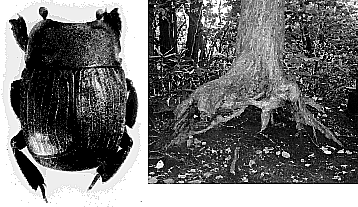Type species: Margarinotus (Myrmecohister) maruyamai M. Ohara, 1999

Figs. Margarinotus (Myrmecohister) maruyamai (left). Habitat of M. (M.) maruyamai, at Maruyama, Sapporo, Japan. There is an entrance of the nest Lasius (Dendrolasius) fuliginosus (Formicidae). By cortesy of Mr. M. Maruyama. (right).
Belonging to the genus Margarinotus, with the following combination of
character-states: body shape oblong-oval; pronotum densely covered with
coarse punctures; lateral area of pronotum broadly and strongly excavated
along lateral and latero-anterior margins; epipleura of pronotum without
hair; marginal pronotal, external and internal lateral pronotal striae absent;
external subhumeral stria of elytra complete; dorsal surface of elytra without
projecting tubercle; denticle on outer margin of protibia small; meso- and
metatibiae broad, triangular and strongly dilated; prosternum with carinal
stria; apex of aedeagus of male genitalia with a denticle.
This combination of character-states does not occur in any of the other
subgenera of the genus Margarinotus. The most characteristic state is the
absence of the marginal pronotal and lateral striae. The distinctive combination
of character-states found in this species appears to warrant the erection
of a new subgenus within the genus Margarinotus.
Although Myrmecohister somewhat deviates from other Margarinotus species,
several characters in aedeagus of male genitalia clearly indicate a monophyletic
origin with that genus, while the presence of an apical denticle on median
lobe of aedeagus suggests a close relationship with the subgenus Paralister
and some species of the subgenus Ptomister, e.g. merdarius, tristriatus,
koltzei and hailar.
The subgenus Myrmecohister superficially resembles Psiloscelis spp. in North
America; however, it can easily be distinguished by the structure of male
genitalia, that is, the presence of median armature of aedeagus. Psiloscelis
is allied to the genera Hister, Merohister and Atholus rather
than to Margarinotus, on the basis of their structure of male genitalia.
To include the new subgenus, some couplets in my key to the subgenera
of the genus Margarinotus (Ohara, 1994: 138) should be changed as follows:
1 (2) Lateral sides of pronotum strongly depressed or excavated. Intercoxal
disk of metasternum wholly covered with coarse punctures.
1a (1b) Lateral pronotal stria present. Body size small, PPL 4.0-4.25 mm.
Lateral side of pronotum strongly depressed, the disk covered with coarse
punctures only along lateral margin. ............................... Subgenus
Kurilister Tishechkin, 1992
1b (1a) Lateral pronotal stria absent. Body size large, PPL 6.62-7.31 mm.
Lateral side of pronotum excavated, the disk wholly covered with coarse
puncture. ........................................ Subgenus Myrmecohister
M. Ohara, n. subgen.
.......................................................................
M. (M.) maruyamai M. Ohara, n. sp.
2 (1) Lateral sides of pronotum not depressed. Intercoxal disk of metasternum
not punctate (rarely punctate, with punctures only along lateral metasternal
stria).